How to Build a Customer-Driven Marketing Strategy
By Chris Bass December 15, 2021
Ultimately, the success (or failure) of your business can depend on how well you’ve applied customer feedback to your brand, products and services, work processes, and everything in between.
“Customer service shouldn’t just be a department, it should be the entire company”
Tony Hsieh, entrepreneur and former CEO of Zappos
Why is Tony right? Why is feedback so enormously important? Because any feedback, especially the critical kind, helps us create our approach and product offering to be exactly what our customers actually want.
Here’s the good news: Feedback is easy to collect. 85% of customers are likely to give positive feedback and 81% of customers are likely to give feedback when they’ve had a bad experience, according to research by Survey Monkey.
Knowing your audience’s likes and dislikes (and the reasons for them) allows you to make key improvements you didn’t know you needed to make.
When done right, those improvements lead to increased customer satisfaction, advocacy, and loyalty to your company.
In this article we’ll show you effective ways to create a healthy customer feedback loop. We’ll then cover examples of how to use feedback to develop a customer-driven marketing strategy that fuels your growth.
How to collect customer feedback to guide a successful marketing strategy
Start your customer-focused marketing strategy with a simple playbook. This playbook will help you collect feedback at every stage of the customer lifecycle — throughout their experience working with you.
You can then use the information you collect to make product updates, alter how you deliver services, or even refine your communication style.
When to ask for feedback: A 4-stage playbook
- When a customer has just begun to engage with you – initial collection touchpoints
- After purchase/using your services – cadence for in-depth knowledge
- Issue handling – all hands customer service
- If (hopefully not when) they move on from your business – lesson learning
Stage 1: On initial engagement
Collection method: Newsletter signup
One of the first interaction points is when new leads sign up to receive your newsletter. This is the perfect opportunity to ask about content or news preferences — right in the sign up form (i.e., are you interested in events, brand updates, or product news only?).
As your customer or email list grows, you’ll see which topics are most popular to your customers. That will help you understand the interest areas that are important for your business.
In AWeber, you can add custom fields to a sign up form or landing page to collect this information. These custom fields will add tags to your subscribers.
Use segmentation to personalize your marketing outreach by sending news unique to each customer group. The result is higher customer engagement and increased sales.
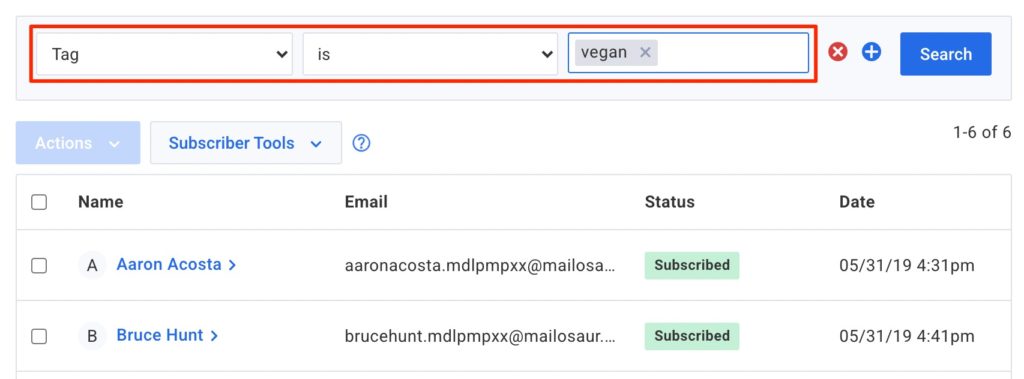
Collection method: Online survey
Post-purchase, or at the conclusion of a free trial period (24–48 hours after purchase or the trial period ends) is a great time to survey your customer.
You’ll learn why they bought and what they liked, or conversely, what might be preventing them from moving forward.
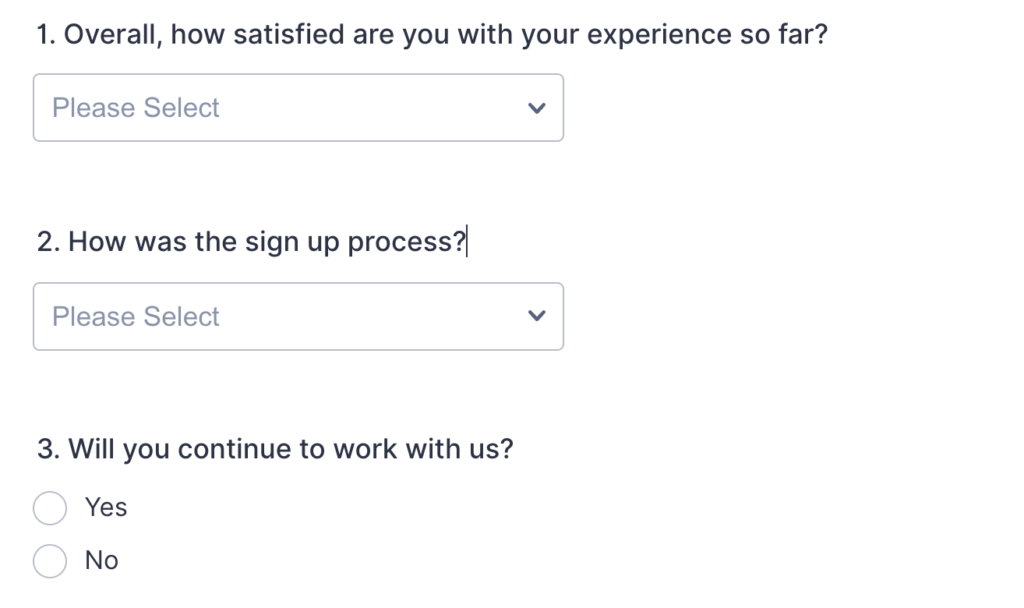
When it comes to how many questions to include in a survey, the ones that tend to see high response rates don’t take longer than 10 minutes, which equates to about 5-10 questions.
The feedback you get here will go a long way toward helping you create a good initial impression — which is crucial to keep and resell to your new customers.
Stage 2: After purchase – monthly or quarterly
Collection method: Customer interviews
Whether you’re a solo entrepreneur or a large company, you should reach out to your customers on an ongoing basis. This is particularly helpful for getting in-depth opinions on new features or ideas you have for future developments.
Talk to your customers (via phone or videoconference). You’ll get invaluable, direct feedback that will either reinforce your ideas or help you pivot.
A great way to collect and create a database of what matters to customers is with services like Lookback, which will help you discover and keep track of what your customers said.
Collection method: Online or mobile surveys
Send a survey to your customers after they have used your product or service for at least 3 months, and then check in monthly or quarterly.
Think of surveys as the foot soldiers collecting customer feedback: They’re easily assembled and deployed, and they’re flexible enough to cover many interaction points.
Plus, by using surveys to gather feedback, it’s simple to categorize, report on, and share that feedback with your team so that you can take action later on.
Jotform, a full featured and free no-code survey tool, integrates with AWeber and offers a number of helpful, post-purchase survey templates, user experience surveys, and more.
It’s easy to send new subscriber info from your survey, customer feedback form, or contact form straight to your AWeber lists. (Plus, Jotform offers beautiful templates like the one below to make giving feedback engaging.)
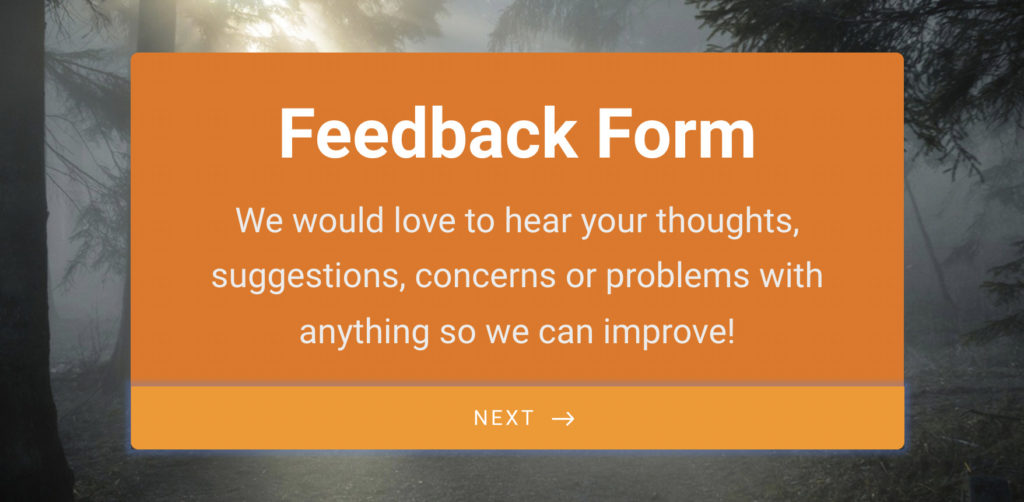
Pro tip: Contact forms are a sneaky good way to solicit feedback. Simply add a text field at the bottom of your form with a heading like “Anything you’d like us to know?” or a similar phrase.
Stage 3: If there’s an issue
Collection method: Customer service
When customers have product, service/communication, or other issues, it’s a great time to learn what needs to be fixed to increase customer engagement. Fielding these requests helps you discover which issues demand immediate attention.
Categorize your customers’ issues to summarize areas that need attention so they can be integrated with your marketing plans later on.
Address any issues head-on and directly, but afterwards get additional feedback. What went wrong? How was it resolved? How could you do better to avoid issues the next time. Trigger an automated email in AWeber using a tag to collect this information without extra manual work.

For small businesses in need of customer service software solutions, companies like EngageBay and Zendesk offer live chat and knowledge bases that allow you to get your solution off the ground (note that setting up a knowledge base takes time).
Collection method: Social media monitoring
If you or your business have a solid social media following, it’s a good idea to track hashtags and mentions so you can stay on top of what’s being said about your brand. It’s quite common, and frankly easier, for customers to voice their issues (or positive reactions) on social media.
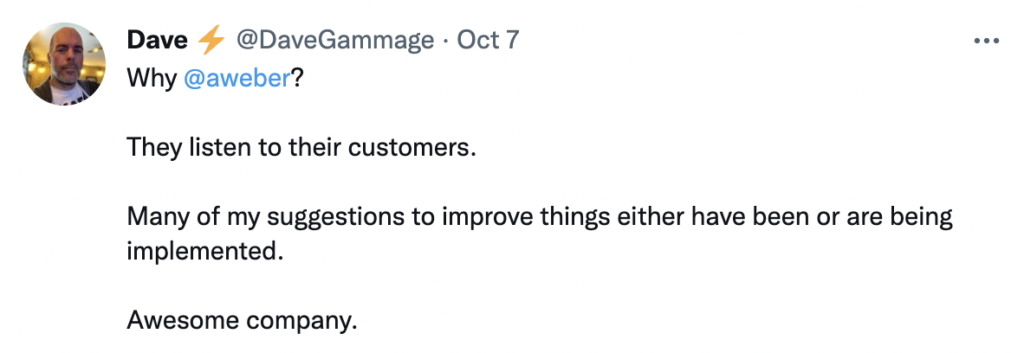
By monitoring this info, you’ll collect valuable metrics and qualitative info — inspiration for your marketing strategy. Social monitoring tools such as Reputology let you easily analyze the conversations your audience is having.
Stage 4: If/when customers move on from your business
Collection method: Churned customer surveys
It’s no fun losing customers. But when a customer leaves, it’s a best practice to send them a feedback survey. That’s because when they leave, they tend to speak more candidly than usual (if they speak at all).
Pay attention to customers that take the time to give feedback. Chances are you’ll learn very valuable information that will help you build customer loyalty — or even win lost customers back.
Share feedback with all staff so it becomes second nature
It’s important to make sure the feedback you collect is shared so that everyone is aware of it.
This could mean setting up automated email notifications whenever you receive feedback. Or it could be more informal, like a themed meeting or day dedicated to review positive and constructive feedback.
The point is, you want customer feedback to become a habit in all your processes.
Pro tip: Remember that some of the feedback you get will come organically and unsolicited — offline. Try to remember and record this info as efficiently as you can so it can be fed into your feedback engine, table, or spreadsheet for sharing later on.
How to use this feedback to build a customer-focused marketing strategy
Now let’s dive into how you can apply customer feedback when building your marketing strategy. It’s easier than you think.
For example, use the feedback you’re getting on social media to assemble a marketing to-do list that improves your brand and reinforces authenticity.
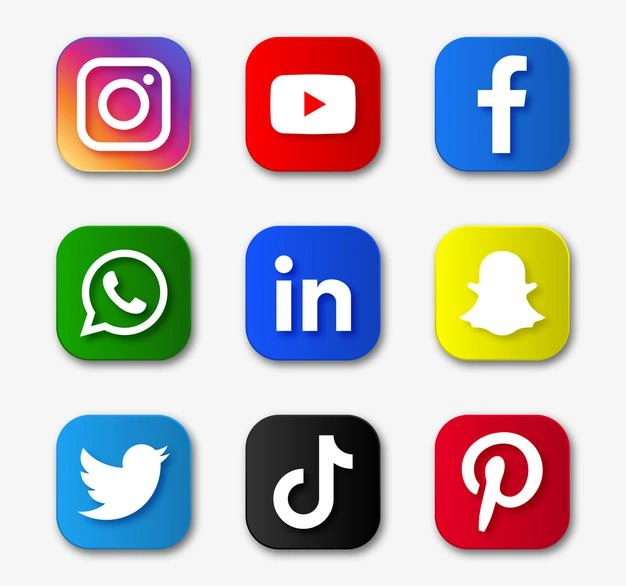
Your social media marketing to-do list could look something like this:
- When branding (social/email), highlight the things your customers like about your business and how it fits with your mission.
- Create hashtags of cute or creative customer descriptions of your brand and share them on all channels.
- Use positive social mentions when demonstrating how you help customers solve problems, and thank/tag contributors directly.
- Use creative feedback to brainstorm new ways to market your business like creating a TikTok video or partnering on a webinar.
- Establish which social media channels your customers respond to best and align your brand’s tone to that channel’s personality.
Another action list, inspired by feedback from existing customers, can strengthen your overall customer experience. That list could include
- Increasing the type or number of your most popular products or services based on product feedback
- Using communication-based feedback to increase/decrease email sends and give customers alternative ways of reaching you (chat, text, etc.)
- Learning how to differentiate your brand from the competition by using feedback as a basis for a SWOT analysis brainstorming session
Note: Use positive customer feedback as words of encouragement for your staff. Doing so has the wonderful effect of creating a happier workplace and encouraging higher productivity.
Now let’s look at a couple real life cases of feedback fueling a marketing strategy.
Example: How Mike’s Bikes does it
Let’s suppose the majority of the feedback you’re getting is service-related and/or dealing with issues that need attention. That’s the case for entrepreneur Tom Casson, vice president of Mike’s Bikes.
“The majority of our customer feedback relates to our customer service. Whether we knocked it out of the park or have gotten feedback letting us know where we fell short and needed improvement…. Recently, our feedback has come from customers loving the convenience of our Mike’s Bikes Mobile Service solution.”
Right off the bat, the service-related feedback Mike’s Bikes gets reinforces what the company is doing well and suggests what needs to improve.
Casson has also set up customer communications to capture a variety of feedback. It starts with post-purchase emails and social media monitoring (including Yelp/Google), all of which funnels into a customer service solution (Zendesk).
By tackling the first two steps, Casson understands how to use customer feedback to improve the company’s process and properly inform his marketing decisions, rounding out the playbook.
“We have definitely used customer feedback to make internal and external decisions,” Casson says. “Whether it’s speeding up the delivery of a bike, taking the extra time and care to help the customer get set up on their new bike, or noticing trends among products that we’re receiving great feedback on. All of these improvements have come from direct feedback from our customers.”
Take it past review forms: Conduct customer interviews
Closely related to service issues are first-person customer interviews and product or service requests. Often, these can apply to your marketing strategy by helping you identify new growth areas and potential audiences for your business.
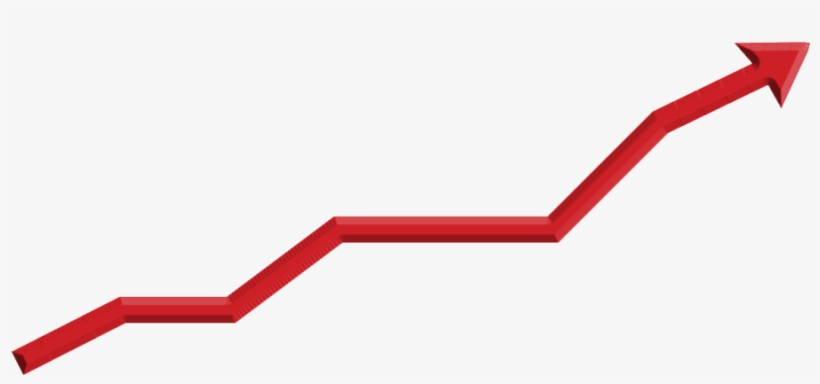
For example, at Jotform we noticed a 179 percent increase in mobile form views over three years combined with customer requests for the ability to “bundle” forms in one place. That led to the creation of a beta mobile product that a select group of customers were able to try out.
By interviewing that group of customers about their usage, we learned what worked, what didn’t, and what was missing from the product. Eventually, the product we introduced was Jotform Apps, which has turned out to be wildly popular with customers.
Conclusion: Research, review, and repeat
A customer-focused marketing strategy isn’t a one and done; it’s a continual process. Your strategy will boost growth and differentiate your offering, if you consistently integrate customer feedback into what you do.
Tom Casson put it best: “Customers are the core of our business. Any opportunity we have to receive criticism or positive reinforcement, we jump at the chance to find out more and how to be better next time!”
 87% off ends soon!
87% off ends soon! 
